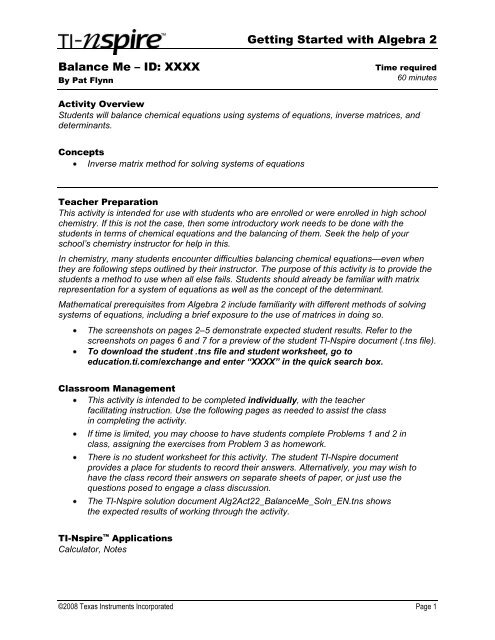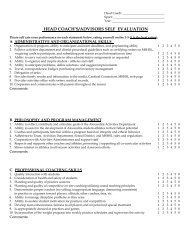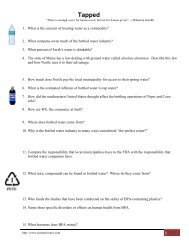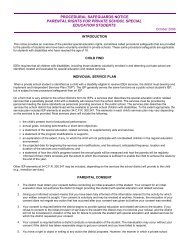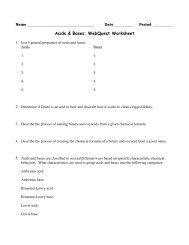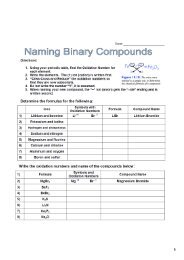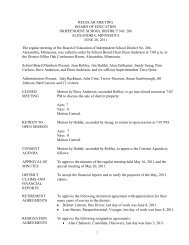Balancing Chemical Equations
Balancing Chemical Equations
Balancing Chemical Equations
Create successful ePaper yourself
Turn your PDF publications into a flip-book with our unique Google optimized e-Paper software.
Getting Started with Algebra 2Balance Me – ID: XXXXBy Pat FlynnTime required60 minutesActivity OverviewStudents will balance chemical equations using systems of equations, inverse matrices, anddeterminants.ConceptsInverse matrix method for solving systems of equationsTeacher PreparationThis activity is intended for use with students who are enrolled or were enrolled in high schoolchemistry. If this is not the case, then some introductory work needs to be done with thestudents in terms of chemical equations and the balancing of them. Seek the help of yourschool’s chemistry instructor for help in this.In chemistry, many students encounter difficulties balancing chemical equations—even whenthey are following steps outlined by their instructor. The purpose of this activity is to provide thestudents a method to use when all else fails. Students should already be familiar with matrixrepresentation for a system of equations as well as the concept of the determinant.Mathematical prerequisites from Algebra 2 include familiarity with different methods of solvingsystems of equations, including a brief exposure to the use of matrices in doing so.The screenshots on pages 2–5 demonstrate expected student results. Refer to thescreenshots on pages 6 and 7 for a preview of the student TI-Nspire document (.tns file).To download the student .tns file and student worksheet, go toeducation.ti.com/exchange and enter “XXXX” in the quick search box.Classroom ManagementThis activity is intended to be completed individually, with the teacherfacilitating instruction. Use the following pages as needed to assist the classin completing the activity.If time is limited, you may choose to have students complete Problems 1 and 2 inclass, assigning the exercises from Problem 3 as homework.There is no student worksheet for this activity. The student TI-Nspire documentprovides a place for students to record their answers. Alternatively, you may wish tohave the class record their answers on separate sheets of paper, or just use thequestions posed to engage a class discussion.The TI-Nspire solution document Alg2Act22_BalanceMe_Soln_EN.tns showsthe expected results of working through the activity.TI-Nspire ApplicationsCalculator, Notes©2008 Texas Instruments Incorporated Page 1
Getting Started with Algebra 2Problem 1 – <strong>Balancing</strong> Al O2 Al2O3Problem 1 walks students through how to balance the chemical equationAl O Al O . There are no actions to be performed by students for the first2 2 3three steps; they should just be sure they read and understand each step.Step 1: Assign a variable coefficient to each of thethree terms in the equation: a Al b O2 c Al2O3Step 2: Translate the chemical equation into amathematical system of equations, as shownin the screenshot to the right. There shouldbe an equation for each element in thechemical equation. If needed, remindstudents that the coefficients in these twoequations are derived from the number ofatoms of the element in each chemicalcompound.Step 3: Write the system of equations as a matrixequation. For students who are comfortablewith using matrices to solve equations, thismatrix equation should look familiar, exceptfor the appearance of the scalar, c. Tellstudents that a value will be chosen for c inthe next step.Step 4: Page 1.6 explains that the absolute value ofthe determinant of the coefficient matrixshould be used as the value of c.Using the determinant ensures that the values found for a and b inthe next step are integers. Ask students why it makes sense to use theabsolute value of the determinant (c must be a positive integer; itrepresents a number of molecules.)Students may recall that the determinant of aa b2×2 matrix A is given byc ddet( A)ad bc , but students can use themathematical capabilities of the Notesapplication to evaluate the determinant.Instruct them to hold down the SHIFT key(g) while they arrow over the expression toselect it, and choose Evaluate Selection fromthe Actions menu. Pressing · will return thevalue of c; here, 2.©2008 Texas Instruments Incorporated Page 2
Getting Started with Algebra 2Step 5: To solve this equation forab, both sides ofthe equation must be multiplied by theinverse of the coefficient matrix. Remindstudents that matrix multiplication is notcommutative, and must be done in the ordershown. Students should substitute 2 for cand then they can use Evaluate Selectionon the selection shown to the right toa 4determine .b 3Step 6: Now, students need to substitute the values they obtained for a, b, and c,and check that the values indeed balance the chemical equation.4 Al 3 O2 2 Al2O3According to these values, there are 4 aluminum atoms on the left-handside and 2 × 2 = 4 aluminum atoms on the right-hand side, so thealuminum is balanced. Similarly, there are 3 × 2 = 6 oxygen atoms onthe left and 2 × 3 = 6 oxygen atoms on the right. Therefore, the chemicalequation is balanced.Problem 2 – <strong>Balancing</strong> C2H6 O2 CO2 H2OProblem 2 asks students to balance the chemicalequation C2H6 O2 CO2 H2O . Note that thisequation has four terms and three elements, so it willrequire a system of three equations, rather than two.For this example, students will complete more of therequired steps themselves.Step 1: Assign a variable coefficient to each of thefour terms in the equation.Step 2: Translate the chemical equation into amathematical system of equations, as shown.On page 2.3, students will find there is an extra step required here. The “c”terms should be subtracted from both sides in order to isolate the “d” term onthe right-side of the equation. Students can copy (/ + C) and paste(/ + V) their equations from page 2.2 to page 2.3 instead of retyping them.)After manipulation, the equations should be as shown below.C: 2a 0b 1c 0dH: 6a 0b 0c 2dO: 0a 2b 2c 1d©2008 Texas Instruments Incorporated Page 3
Step 3: Write the system as a matrix equation. Here,the coefficient matrix is a 3×3 matrix, asshown to the right.Step 4: Find the value of d. This coefficient matrixhas a determinant of –12, so this is anexample of why you should use the absolutevalue of the determinant. Again, studentscan use copy/paste and the mathematicalcapabilities of the Notes application to findthis value.Step 5: The values for a, b, and c may then be found as shown below.Getting Started with Algebra 2abc12 0 1 0 46 0 0 12 2 140 2 2 1 8Step 6: Now, the values of a, b, c, and d may besubstituted back into the original chemicalequation. However, students are not ready tocheck their solutions.Be sure students understand the informationon page 2.6 regarding reducing thecoefficients in a chemical by any commonfactors.Students should then check these reducedvalues, as before, on page 2.7.Problem 3 – More practiceProblem 3 provides students with eight exercises to practice balancing chemicalequations using inverse matrices and determinants. Students may answerdirectly in the student TI-Nspire document (see TI-Nspire solution document) oron separate sheets of paper. Solutions to each problem and given below.1. Mg P4 Mg3P22. H2 N2 NH3aMg bP4 c Mg3P2Mg: 1a 0b 3c 1 0 a 3cP: 0a 4b 2c 0 4 b 2aH2 bN2 c NH3H: 2a 0b 3c 2 0 a 3cN: 0a 2b 1c 0 2 b 1c4;ab122c4;ab6212Mg 2P4 4 Mg3P2, which reduces to:6Mg P4 2 Mg3P26H2 2N2 4 NH3, which reduces to:3H2 N2 2 NH3©2008 Texas Instruments Incorporated Page 4
Getting Started with Algebra 23. aP4 bO2 c P2 O5P: 4a 0b 2c 4 0 a 2cO: 0a 2b 5c 0 2 b 5c8;ab4204P4 20O2 8 P2 O5, which reduces to:P4 5O2 2 P2 O54. aSb bO2 c Sb4O6Sb: 1a 0b 4c 1 0 a 4cO: 0a 2b 6c 0 2 b 6c2;ab868Sb 6O2 2 Sb4O6, which reduces to:4Sb 3 O2 Sb4O65. aKO2 bCO2 cK2CO3 d O2K: 1a 0b 2c 0d 1 0 2 a 0O: 2a 2b 3c 2d 2 2 3 b d 2C: 0a 1b 1c 0d 0 1 1 c 06. aFe2O3 bCO cFe d CO2Fe: 2a 0b 1c 0d 2 0 1 a 0O: 3a 1b 0c 2d 3 1 0 b d 2C: 0a 1b 0c 1d 0 1 0 c 1da43; b 2c2da13; b 3c24KO 22CO 22K 2CO3 3 O2Fe2O3 3CO 2Fe 3 CO27. aC3H8 bO2 cCO2 d H2OC: 3a 0b 1c 0d 3 0 1 a 0H: 8a 0b 0c 2d 8 0 0 b d 2O: 0a 2b 2c 1d 0 2 2 c 1da416; b 20c124C3H 820O2 12CO 216 H2O,which reduces to:C3H8 5O2 3CO 24 H2O8. aC2H3Cl bO2 cCO2 dH2O e HClC: 2a 0b 1c 0d 0eH: 3a 0b 0c 2d 1eCl: 1a 0b 0c 0d 1eO: 0a 2b 2c 1d 0ee4;abcd410842 0 1 0 a 03 0 0 2 b 1e1 0 0 0 c 10 2 2 1 d 04C2H 3Cl 10O2 8CO 24H2O 4 HCl ,which reduces to:2C2H 3Cl 5O2 4CO 22H 2O 2 HCl©2008 Texas Instruments Incorporated Page 5
Getting Started with Algebra 2Balance Me – ID: XXXX(Student)TI-Nspire File: Alg2Act22_BalanceMe_EN.tns©2008 Texas Instruments Incorporated Page 6
Getting Started with Algebra 2©2008 Texas Instruments Incorporated Page 7


